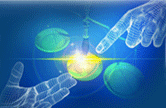 |
| ||||||||||||||||||||
|
| |||||||||||||||||||||
Pulse Oximetry in the External Auditory Canal
|

Custom Search
Abstract of "Pulse Oximetry in the External Auditory Canal" Project In this paper, we introduce a new sensor technology for measuring plethysmographic parameters, i.e., for pulse oximetry, particularly in mobile people. The sensor uses the auditory canal as a measuring site, plus a novel light path through the tissue of the auditory canal's wall for continuously and reliably measuring arterial oxygen saturation and heart rate under mobile conditions. Measurements with this sensor technology reveal a good ratio in combination with excellent signal quality - ideal prerequisites to make pulse oximetry a continuous unobtrusive mobile monitoring technology. Methods and apparatus for detecting oxygen saturation levels in blood from within an auditory canal of a living being proximal to a tympanic membrane are disclosed. The auditory canal is lined with tissue and includes a proximal bend and a distal bend located between the proximal bend and the tympanic membrane. Oxygen levels are detected by emitting one or more wavelengths of light into a first position on the tissue of the auditory canal in a first region defined by the distal bend and the tympanic membrane. The wavelengths of light are then sensed at a second position on the tissue of the auditory canal in the first region. A blood oxygen saturation level and/or pulse rate is then calculated responsive to intensity information corresponding to the wavelengths of light detected at the second position. Field of the Invention The present invention relates to the field of medical devices and, more particularly, to noninvasive pulse oximetry methods and apparatus for use inside an auditory canal of a living being. Background of the Invention An oximeter calculates blood oxygen saturation levels within a living being from the different rates at which oxygenated hemoglobin (oxyhemoglobin) and reduced hemoglobin (deoxyhemoglobin) within vascular tissue of the living being absorb light of different wavelengths. Typically, two wavelengths of light are used where one wavelength is much less sensitive to blood oxygen saturation levels than the other. The wavelength of light that is less sensitive to oxygen saturation levels serves as a constant against which the wavelength of light that is more sensitive to oxygen saturation levels is compared in order to calculate blood oxygen saturation levels. The measurement of oxygen saturation levels (“oximetry”) is a critical physiologic measurement for critical care patients. Presently, sensors for use with oximeters to measure oxygen saturation levels in vascular tissue are designed for placement on a finger, ear lobe, foot, or in an outer portion of the auditory canal. These sensors are subject to motion artifacts that may result in inaccurate measurements. Accordingly, improved oximetry methods and apparatus are needed that are not subject to this limitation. The present invention addresses this need among others.
Related Projects : Zigbee Based Patient Analysing System with WAP , Application of Stem Cell Therapy in Spinal Cord Injuries , Advanced Patients Monitoring Through CCTV Camera , 3-D Pharmacophore Modelling , Wearable Object Detection System for the Blind , Low Cost Solar ECG with Bluetooth Transmitter , Microphone Array System for Automatic Fall Detection
<< back |
| All
rights reserved ® Copyright © V2computers 2007 through 2017 |